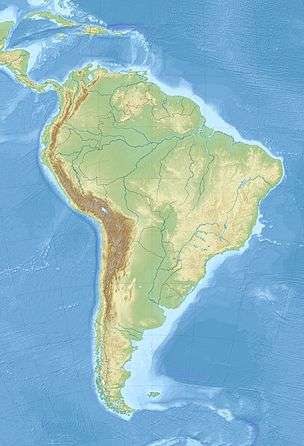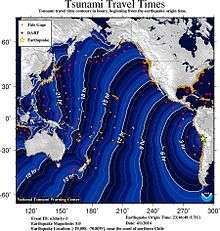2014 Iquique earthquake
 Iquique Santiago | |
| Date | 1 April 2014 |
|---|---|
| Origin time | 20:46 CST (UTC-03:00) |
| Magnitude | 8.2 Mw[1] |
| Depth | 20.1 km (12.5 mi)[1] |
| Epicenter | 19°38′31″S 70°49′01″W / 19.642°S 70.817°W[1] |
| Areas affected | Chile, Peru, Bolivia |
| Total damage | 2,500 homes damaged |
| Max. intensity | VIII (Severe) |
| Tsunami | Yes |
| Casualties |
Chile: 6 dead [2][3][4] Peru: 9 injured[5][6] |
The 2014 Iquique earthquake struck off the coast of Chile on 1 April, with a moment magnitude of 8.2, at 20:46 local time (23:46 UTC).[7][8] The epicenter of the earthquake was approximately 95 kilometres (59 mi) northwest of Iquique.[1] The mainshock was preceded by a number of moderate to large shocks and was followed by a large number of moderate to very large aftershocks, including a M7.7 event on 3 April. The megathrust earthquake triggered a tsunami of up to 2.11 metres (6.9 ft) that hit Iquique at 21:05 local time (00:05 UTC, 2 April).[9] Similar-sized tsunamis were also reported to have hit the coasts of Pisagua and Arica.[10]
Geology
A number of mid-sized quakes struck the same area in the preceding weeks. These quakes and the main tremor are associated with the boundary of the Nazca Plate and the South American Plate.[1]
Earthquake
There was a cluster of earthquakes starting from the one occurring on March 16 with a magnitude of Mw 6.7, and a large earthquake had been expected.[11][12] The 8.2 earthquake was smaller than what was expected, with a rupture of 200 km (120 mi) in length instead of the expected 600 km (370 mi) rupture.[13] The earthquake was felt in Chile, Peru, and Bolivia.[14] The intensity reached intensity VIII (Severe) in Iquique, Chile.[15]
Effects
Four men died of heart attacks and one woman was reportedly crushed to death when a wall collapsed. A loader was crushed by a falling metal structure and died of the injuries afterwards.[16] Around 80,000 were displaced by the event.[17] Electricity and water services were interrupted in the regions of Arica y Parinacota and Tarapacá.[18]
During the aftermath of the earthquake, 293 prisoners escaped from a women's prison in Iquique when a wall collapsed. Many returned voluntarily a short time later, while Chilean soldiers searched for the rest.[19]

According to the Peruvian emergency services, nine people were slightly injured, seven households have been affected, one temple has collapsed and electricity outages in the affected regions of Tacna, Moquegua and Arequipa occurred, which were restored later.
Aftershocks
There were several significant aftershocks above 6.0 magnitude and many more of lower magnitude over subsequent days.
| Time (local) | M | Depth | Epicenter | |
|---|---|---|---|---|
| April 1 at 20:57:58 | 6.9 | 28.4 km (17.6 mi) | 91 km (57 mi) WNW of Iquique | [20] |
| April 2 at 22:58:30 | 6.5 | 24.1 km (15.0 mi) | 46 km (29 mi) WSW of Iquique | [21] |
| April 2 at 23:43:13 | 7.7 | 22.4 km (13.9 mi) | 53 km (33 mi) SW of Iquique | [22] |
| April 3 at 02:26:15 | 6.4 | 25 km (16 mi) | 78 km (48 mi) SW of Iquique | [23] |
| April 3 at 22:37:50 | 6.3 | 13.7 km (8.5 mi) | 70 km (43 mi) SW of Iquique | [24] |
Associated events
Such large earthquakes can have effects far away other than tsunamis.[25] A megathrust quake can shake the entire earth, but causes stronger movement and strain on the entire associated oceanic plate, beyond the few hundred kilometer rupture zone. Though too far to be an aftershock, a 6.0 quake on a thin protruding wedge of the Nazca Plate (Iquique quake shoved this plate) was reported off Panama within 12 hours of the main shock.[26]
Tsunamis

Under advice from the Pacific Tsunami Warning Center, tsunami warnings were issued for the Latin American Pacific coastlines of Chile, Peru, and Ecuador shortly after the earthquake occurred.[4][7][27] Chile was subsequently hit by a tsunami of 2.11 m in its northern territories.[9]
The tsunami warning was later canceled for all countries except Chile and Peru within a few hours of the earthquake.[28] The tsunami warning was canceled for both Chile and Peru at around 4:58 UTC on 2 April. Hawaii was under a tsunami advisory for over 13 hours.[29][30] On April 3 local time, tsunamis were observed in Japan.[31] The tsunami reached 60 centimetres (2.0 ft) high in Kuji, Iwate Prefecture, Japan.[32]
See also
- 1868 Arica earthquake
- 1877 Iquique earthquake
- 2010 Chile earthquake
- List of earthquakes in 2014
- List of earthquakes in Chile
References
- 1 2 3 4 5 "M8.2 - 95km NW of Iquique, Chile". United States Geological Survey. Retrieved 2 April 2014.
- ↑ "Chile earthquake: 2 dead, 3 seriously injured". Canadian Broadcasting Corporation. 2 April 2014.
- ↑ Franklin, Jonathan; Davidson, Helen; Farrell, Paul (2 April 2014). "Chile earthquake triggers tsunami warning and evacuation – live updates". The Guardian. Retrieved 4 April 2014.
- 1 2 Stout, David; Winograd, David (1 April 2014). "Five Dead After Huge Quake Hits off Coast of Chile". TIME. Retrieved 2 April 2014.
- ↑ "Massive earthquake and tsunami at the Tarapaca coast, Northern Chile – The full story from the very beginning". Earthquake-Report.com.
- ↑ "Chile Lifts Tsunami Warning After Quake Kills 6". 2 April 2014.
- 1 2 "Tsunami alert after 8.2 quake strikes off Chile". BBC. 1 April 2014. Retrieved 2 April 2014.
- ↑ Shabner, Dean (1 April 2014). "8.2-Magnitude Earthquake Off Chile Triggers Tsunami". ABC News. Retrieved 1 April 2014.
- 1 2 "Pacific Tsunami Waves hit Chile after an Earthquake measuring 8.3". IANS. news.biharprabha.com. Retrieved 2 April 2014.
- ↑ Tsunami Message Number 6, NWS Pacific Tsunami Warning Center, 1 April 2014
- ↑ "Magnitude-6.7 quake hits Chile, 100,000 evacuated". USA Today.
- ↑ "Earthquake Report (Informe de Sismo Sensible)" (in Spanish). Sismologia.cl. 16 March 2014. Retrieved 4 April 2014.
- ↑ "La estrella de Iquique", 2 April 2014, page 5
- ↑ "Tsunami alert after 8.2 quake strikes off Chile". BBC News. 2 April 2014. Retrieved 4 April 2014.
- ↑ "M8.2 - 95km NW of Iquique, Chile 2014-04-01 23:46:46 UTC". U.S. Geological Survey. 4 April 2014. Retrieved 4 April 2014.
- ↑ "La estralla de Iquique", April 4, 2014, page 10
- ↑ "8.2 earthquake hits Chile, killing 6 and displacing 80,000". RT. 2 April 2014.
- ↑ Moreno, Génesis; Paz Núñez, María (2 April 2014). "Replenishment of basic services has been slower in communes of Iquique and Alto Hospicio (Reposición de servicios básicos ha sido más lenta en comunas de Iquique y Alto Hospicio)" (in Spanish). La Tercera. Retrieved 4 April 2014.
- ↑ Amos, Jonathan (2 April 2014). "Chile soldiers hunt escaped inmates in quake-hit Iquique". BBC News.
- ↑ USGS. "M6.9 - 91km WNW of Iquique, Chile". United States Geological Survey.
- ↑ USGS. "M6.5 - 46km WSW of Iquique, Chile". United States Geological Survey.
- ↑ USGS. "M7.7 - 53km SW of Iquique, Chile". United States Geological Survey.
- ↑ USGS. "M6.4 - 78km SW of Iquique, Chile". United States Geological Survey.
- ↑ USGS. "M6.3 - 70km SW of Iquique, Chile". United States Geological Survey.
- ↑ Lubick, Naomi (March 2003). "Triggered Swarms: How Big Quakes Can Cause Small Quakes Far Away". Scientific American. Retrieved 4 April 2014.(subscription required)
- ↑ "M6.0 - 52km S of Pedregal, Panama 2014-04-02 16:13:27 UTC". U.S. Geological Survey. 3 April 2014. Retrieved 4 April 2014.
- ↑ "Tsunami Warning and Warch for Latin American Pacific coastline". Pacific Tsunami Warning Center. 2014-04-01. Retrieved 2014-04-02.
- ↑ "Tsunami Warning and Watch Cancellation". Pacific Tsunami Warning Center. 2014-04-02. Retrieved 2014-04-02.
- ↑ "Hawai'ian Islands Tsumani Advisory". Pacific Tsunami Warning Center. 2014-04-02. Retrieved 2014-04-02.
- ↑ "Hawai'ian Islands Tsunami Advisory Cancellation". Pacific Tsunami Warning Center. 2014-04-02. Retrieved 2014-04-02.
- ↑ "Japan hit by Tsunami waves on 3 April after Chilean Earthquake". IANS. news.biharprabha.com. Retrieved 3 April 2014.
- ↑ "60 cm Tsunami Observed in Kuji City, Iwate Prefecture; Caused by Chile Quake (岩手県久慈市で津波60センチ観測 チリ地震)" (in Japanese). Asahi Shimbun Company (朝日新聞). 3 April 2014. Retrieved 4 April 2014.
Further reading
- Lay, Thorne; Yue, Han; Brodsky, Emily E.; An, Chao (16 June 2014). "The 1 April 2014 Iquique, Chile, 8.1 earthquake rupture sequence". Geophysical Research Letters. 41 (11): 3818–3825. doi:10.1002/2014GL060238.
External links
| Wikimedia Commons has media related to 2014 Iquique earthquake. |
- M8.2 - 95km NW of Iquique, Chile – United States Geological Survey
- Tsunami alert after 8.2 quake strikes off Chile – BBC News
- 5 Dead After Powerful Quake Strikes Off Chile's Coast – ABC News
- Powerful earthquake strikes off Chile – CNN
- Tsunami Animation: Iquique, Chile, 1 April 2014 – National Tsunami Warning Center